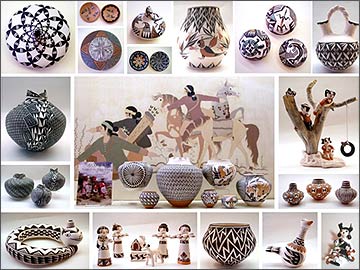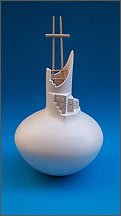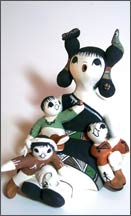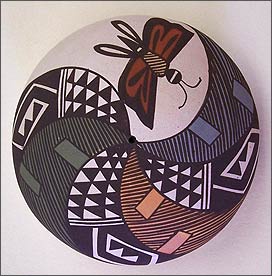Home
About Us
Current News
Event Calendar
Artist Bios
ARCHIVES
Display IDEAS
Collecting Tips
Gen Arts/Crafts Info
Testimonials
Hours/Directions
Online Store
ARCHIVES - Artist / Highlight of the Month

ACOMA POTTERY - March 2006
The Highlight of the Month program at The Indian Craft Shop focuses on a particular craft area, region or artist family/group. Our aim is to illustrate the diversity of tribal groups and the wide variety of artistic expressions and traditions in the country today.

Acoma potters are famous for their beautiful hand coiled white clay pots, some with walls so thin they ring with the clarity of a bell. The tradition of pottery-making has been handed down through the generations with pride. The Pueblo of Acoma is the oldest continuously inhabited community in North America. Located fifty miles west of Albuquerque, New Mexico, Sky City sits on 70 acres atop a 500-foot high mesa.


Pottery is essential to the life of the Pueblo and potters have held a respected place in the society. More than utilitarian, vessels have been used in social and ceremonial functions. Over time, they have become an important trade item, first to other tribes, and then to the general market. Today, sales of pottery are important to the tribal economy and potters are recognized for this exquisite and time consuming artform.


Traditional Acoma pottery is made from natural clays, minerals and plants found in the area. Pottery shards from broken pottery are mixed into the clay. Old shards found in the mesas and fields are especially prized because they represent a link to the ancestors. Preparing the local clay is difficult. It is dense and must first be ground into a fine powder. It takes hours to mix with temper, then clean, soak, dry, crumble and sift over and over again.
The precious white clay used for the polishing coat of Acoma pottery is said to be rare and difficult to gather. The distinctive Acoma slips are sometimes derived from plants, but most are dug locally. Traditional Acoma pottery is fired at a very high temperature to make the pots stronger. Since the early 1970s, most potters fire their pots in an electric kiln that reaches the steady high temperatures needed to reduce breakage in the firing. Pots are made in a variety of shapes – large water jars, called “ollas” that could be carried on the head; grain storage jars; canteens for carrying water to the fields or on horseback; pitchers; seed jars to store small seeds; and bowls in a number of sizes used for bread dough, washing hair, bathing babies and to keep cornmeal used for ceremonies. The designs are distinctive – from dazzling fineline geometrics symbolizing the sun, rain, water, feathers, clouds and rainbows, to colorful figurative animals, birds and floral motifs.
Today there is a wide range of potters, from emerging to experts. Prayers are still a part of the gathering, preparation and creation of the pots. Many potters talk of the spirit of each pot and that each has its own life and some talk to the pots as they make them, recognizing the new life they are creating. The time and culture that goes into the creation of a handmade pot is a great gift to be appreciated.
©The Indian Craft Shop 2006


